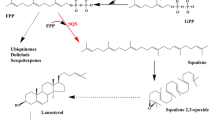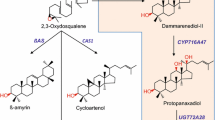Abstract
Glucosinolates are amino acid-derived secondary metabolites present in cruciferous plants. Glucosinolates and their hydrolysis products are involved in defence against insects and pathogens, but are also known for their characteristic flavor and their cancer-preventive and antibacterial properties. This wide range of bioactivities has prompted a desire to engineer glucosinolates into non-cruciferous plants. We report the one-step transfer of the last three steps of the benzylglucosinolate pathway (comprising the C–S lyase, glycosyltransferase and sulfotransferase) from Arabidopsis to tobacco. This was achieved using an expression construct consisting of a single 2A polycistronic open reading frame, which allowed the expression of the three coding-sequences from a single promoter. When compared to wildtype plants, transgenic tobacco lines showed increased ability to convert the intermediate phenylacetothiohydroxamate to benzylglucosinolate upon in vivo feeding. Enzymatic assays using plant extracts demonstrated that the individual activities required for this conversion were enhanced in the transgenic plants. The relatively high conversion by wildtype plants in feeding assays supports the hypothesis that the last part of the glucosinolate pathway was recruited from existing detoxification reactions. Immunoblots confirmed that individual proteins were being successfully produced from the 2A polycistronic open reading frame, albeit fusion proteins could also be detected. In summary, we transferred the last three steps of the benzylglucosinolate pathway to tobacco as a first step towards engineering glucosinolates into non-cruciferous plants.





Similar content being viewed by others

Abbreviations
- ORF:
-
Open reading frame
- BGLS:
-
Benzylglucosinolate
- dBGLS:
-
Desulfobenzylglucosinolate
- PATH:
-
Phenylacetothiohydroxamate
- ST:
-
Sulfotransferase
- GT:
-
Glucosyltransferase
References
Atkins JF, Wills NM, Loughran G, Wu CY, Parsawar K, Ryan MD, Wang CH, Nelson CC (2007) A case for “StopGo”: Reprogramming translation to augment codon meaning of GGN by promoting unconventional termination (Stop) after addition of glycine and then allowing continued translation (Go). RNA 13:803–810
Bianchini F, Vainio H (2004) Isothiocyanates in cancer prevention. Drug Metab Rev 36:655–667
Bones AM, Rossiter JT (2006) The enzymic and chemically induced decomposition of glucosinolates. Phytochemistry 67:1053–1067
Brader G, Mikkelsen MD, Halkier BA, Tapio Palva E (2006) Altering glucosinolate profiles modulates disease resistance in plants. Plant J 46:758–767
Cruz SS, Chapman S, Roberts AG, Roberts IM, Prior DA, Oparka KJ (1996) Assembly and movement of a plant virus carrying a green fluorescent protein overcoat. Proc Natl Acad Sci USA 93:6286–6290
de Felipe P, Luke GA, Hughes LE, Gani D, Halpin C, Ryan MD (2006) E unum pluribus: multiple proteins from a self-processing polyprotein. Trends Biotechnol 24:68–75
Donnelly MLL, Luke G, Mehrotra A, Li X, Hughes LE, Gani D, Ryan MD (2001) Analysis of the aphthovirus 2A/2B polyprotein ‘cleavage’ mechanism indicates not a proteolytic reaction, but a novel translational effect: a putative ribosomal ‘skip’. J Gen Virol 82:1013–1025
Doszczak L, Rachon J (2002) S-thioacyldithiophosphates in the synthesis of thiohydroxamic acids and O-thioacylhydroxylamines. Synthesis 8:1047–1052
Doyle JJ, Doyle JL (1987) A rapid DNA isolation procedure for small quantities of fresh leaf tissue. Phytochem Bull 19:11–15
Ettlinger MG, Lundeen AJ (1957) First synthesis of a mustard oil glucoside; the enzymatic Lossen rearrangement. J Am Chem Soc 79:1764–1765
Fahey JW, Zalcmann AT, Talalay P (2001) The chemical diversity and distribution of glucosinolates and isothiocyanates among plants. Phytochemistry 56:5–51
Fahey JW, Haristoy X, Dolan PM, Kensler TW, Scholtus I, Stephenson KK, Talalay P, Lozniewski A (2002) Sulforaphane inhibits extracellular, intracellular, and antibiotic-resistant strains of Helicobacter pylori and prevents benzo[α]pyrene-induced stomach tumors. Proc Natl Acad Sci USA 99:7610–7615
Fimognari C, Hrelia P (2007) Sulforaphane as a promising molecule for fighting cancer. Mutat Res/Rev Mutat 635:90–104
Geu-Flores F, Nour-Eldin HH, Nielsen MT, Halkier BA (2007) USER fusion: a rapid and efficient method for simultaneous fusion and cloning of multiple PCR products. Nucleic Acids Res 35:e55
Gopinath K, Wellink J, Porta C, Taylor KM, Lomonossoff GP, van Kammen A (2000) Engineering cowpea mosaic virus RNA-2 into a vector to express heterologous proteins in plants. Virology 267:159–173
Grubb CD, Zipp BJ, Ludwig-Muller J, Masuno MN, Molinski TF, Abel S (2004) Arabidopsis glucosyltransferase UGT74B1 functions in glucosinolate biosynthesis and auxin homeostasis. Plant J 40:893–908
Halkier BA, Gershenzon J (2006) Biology and biochemistry of glucosinolates. Annu Rev Plant Biol 57:303–333
Hansen BG, Kliebenstein DJ, Halkier BA (2007) Identification of a flavin-monooxygenase as the S-oxygenating enzyme in aliphatic glucosinolate biosynthesis in Arabidopsis. Plant J 50:902–910
Hansen CH, Du L, Naur P, Olsen CE, Axelsen KB, Hick AJ, Pickett JA, Halkier BA (2001) CYP83B1 is the oxime-metabolizing enzyme in the glucosinolate pathway in Arabidopsis. J Biol Chem 276:24790–24796
Horsch RB, Fry JE, Hoffmann NL, Eichholtz D, Rogers SG, Fraly RT (1985) A simple and general method for transferring genes into plants. Science 227:1229–1231
Kirkegaard JA, Sarwar M, Wong PTW, Mead A, Howe G, Newell M (2000) Field studies on the biofumigation of take-all by Brassica break crops. Aust J Agric Res 51:445–456
Klein M, Reichelt M, Gershenzon J, Papenbrock J (2006) The three desulfoglucosinolate sulfotransferase proteins in Arabidopsis have different substrate specificities and are differentially expressed. FEBS J 273:122–136
Lasken RS, Schuster DM, Rashtchian A (1996) Archaebacterial DNA polymerases tightly bind uracil-containing DNA. J Biol Chem 271:17692–17696
Mikkelsen MD, Naur P, Halkier BA (2004) Arabidopsis mutants in the C–S lyase of glucosinolate biosynthesis establish a critical role for indole-3-acetaldoxime in auxin homeostasis. Plant J 37:770–777
Mlotshwa S, Verver J, Sithole-Niang I, Gopinath K, Carette J, Kammen Av, Wellink J (2002) Subcellular location of the helper component-proteinase of cowpea aphid-borne mosaic virus. Virus Genes 25:207–216
Morant A, Jørgensen K, Jørgensen B, Dam W, Olsen C, Møller B, Bak S (2007) Lessons learned from metabolic engineering of cyanogenic glucosides. Metabolomics 3:383–398
Nour-Eldin HH, Hansen BG, Norholm MHH, Jensen JK, Halkier BA (2006) Advancing uracil-excision based cloning towards an ideal technique for cloning PCR fragments. Nucleic Acids Res 34:e122
Piotrowski M, Schemenewitz A, Lopukhina A, Muller A, Janowitz T, Weiler EW, Oecking C (2004) Desulfoglucosinolate sulfotransferases from Arabidopsis thaliana catalyze the final step in the biosynthesis of the glucosinolate core structure. J Biol Chem 279:50717–50725
Sakaguchi AY, Sedlak M, Harris JM, Sarosdy MF (1996) Cautionary note on the use of dUMP-containing PCR primers with Pfu and VentR DNA polymerases. Biotechniques 21:368–370
Smith BJ, Kirkegaard JA, Howe GN (2004) Impacts of Brassica break-crops on soil biology and yield of following wheat crops. Aust J Agric Res 55:1–11
Tattersall DB, Bak S, Jones PR, Olsen CE, Nielsen JK, Hansen ML, Hoj PB, Moller BL (2001) Resistance to an herbivore through engineered cyanogenic glucoside synthesis. Science 293:1826–1828
Underhill LEW, Wetter LR (1969) Biosynthesis of mustard oil glucosides: sodium phenylacetothiohydroximate and desulfobenzylglucosinolate, precursors of benzylglucosinolate in Tropaeolum majus. Plant Physiol 44:584–590
Walter W, Schaumann E (1971) The chemistry of thiohydroxamic acids. Synthesis 3:111–130
Wittstock U, Kliebensteiin DJ, Lambrix VM, Reichelt M, Gershenzon J (2003) Glucosinolate hydrolysis and its impact on generalist and specialist insect herbivores. In: Romeo JT (ed) Integrative phytochemistry: From ethnobotany to molecular ecology, vol 37. Elsevier, Amsterdam, pp 101–125
Acknowledgments
The authors would like to thank Douglas Grubb, Brandon Zipp (University of California, Davis, USA) and Leszek Doszczak (Universität Würzburg, Germany) for advice on the synthesis of PATH; Claire Halpin (University of Dundee, Scotland) for advice on the 2A system and Bodil Jørgensen (University of Copenhagen, Denmark) for advice on transformation of tobacco. Niels Agerbirk (University of Copenhagen, Denmark) is acknowledged for the kind gift of benzylglucosinolate. This work was supported by the Danish International Developmental Agency (DANIDA, project 91175) and by the Villum Kann Rassmusen Fond through its support to the VKR Research Centre Pro-Active Plants.
Author information
Authors and Affiliations
Corresponding author
Electronic supplementary material
Below is the link to the electronic supplementary material.
Rights and permissions
About this article
Cite this article
Geu-Flores, F., Olsen, C.E. & Halkier, B.A. Towards engineering glucosinolates into non-cruciferous plants. Planta 229, 261–270 (2009). https://doi.org/10.1007/s00425-008-0825-y
Received:
Accepted:
Published:
Issue Date:
DOI: https://doi.org/10.1007/s00425-008-0825-y



